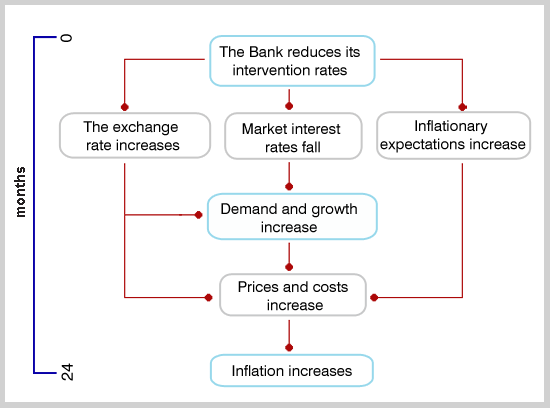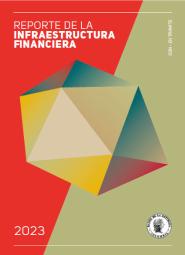How is monetary policy executed in Colombia?
As for the monetary policy instruments used to meet the inflation target, Banco de la República holds repo auctions to provide liquidity to the banking system by granting overnight loans, and occasionally longer ones, all with the purpose of bringing the overnight interbank rate (IBR) near to the benchmark interest rate set by the BDBR. Banks back these loans with securities, mainly government bonds (TES), through repurchase agreements in line with the agreed term. In some cases, when the economy has surpluses in the primary liquidity market, the Bank uses auctions of remunerative deposits not constituting reserves (DRNCE) to drain these surpluses. In both instances, the benchmark interest rate serves as a reference for such operations.
The BDBR meets eight times a year to make monetary policy decisions, specifically in January, March, April, June, July, September, October and December. In preparation for these meetings, the members of the technical staff of the Monetary Policy Department meet with the BDBR to discuss the current state of the economy and the staff’s macroeconomic forecasts. A summary of the information presented to the BDBR by the technical staff is made available to the public in the Monetary Policy Report.
How does monetary policy affect the economy?
When Banco de la República changes the benchmark interest rate it sets in motion a series of forces that, in time, affect market interest rates for different maturities, the exchange rate and inflation expectations. These variables, in turn, influence:
- borrowing costs,
- spending, production, and employment decisions by agents in the economy,
- the exchange rate and asset prices, and
- the inflation rate.
The process whereby monetary policy decisions affect the different economic variables is known as the monetary transmission mechanism, which eventually should lead to an outcome with respect to growth and inflation. The Bank evaluates the effect of monetary policy on the economy through the different transmission mechanisms and is careful to make the necessary changes in its policy so the proposed goals can be achieved.
The following are two general examples of how the transmission mechanism operates.
When the projected inflation rate is below the range:

When the projected inflation rate is above the range:

Why is it important to have low and stable inflation?
Low and stable inflation improves the well-being of the population. This happens in several ways:
- Low inflation encourages efficient use of productive resources. On the contrary, when inflation is high, a portion of a person’s time and the economy’s resources are invested in finding ways to defend against it.
- Low inflation reduces uncertainty and provides more certainty about future returns on investment. It has been observed that economies with high inflation also suffer from more variable inflation. Greater uncertainty can negatively affect the expected return on investments and, therefore, long-term growth. High uncertainty also means relative prices lose their informational content about the relative scarcity or abundance of goods and factors in the economy. This prevents an efficient allocation of resources and results in less economic growth.
- Low inflation encourages investment. The most important economic decisions made by people and business are usually long-term decisions: decisions to build a factory, to start a business, to get an education, to buy a home. These decisions depend fundamentally on the degree of uncertainty about the future. Low and stable inflation is an indicator of macroeconomic stability that helps people and businesses to make investment decisions with confidence.
- Low inflation avoids arbitrary redistribution of income and wealth, especially in the case of the poorest segment of the population. Wage earners and retirees have fewer ways to protect their income from inflationary erosion. The lower a person’s income, the more likely a person is to have fewer mechanisms to defend against inflation, such as savings or real estate. For this reason, rising inflation means a redistribution of income in the case of the poorest population.





















































